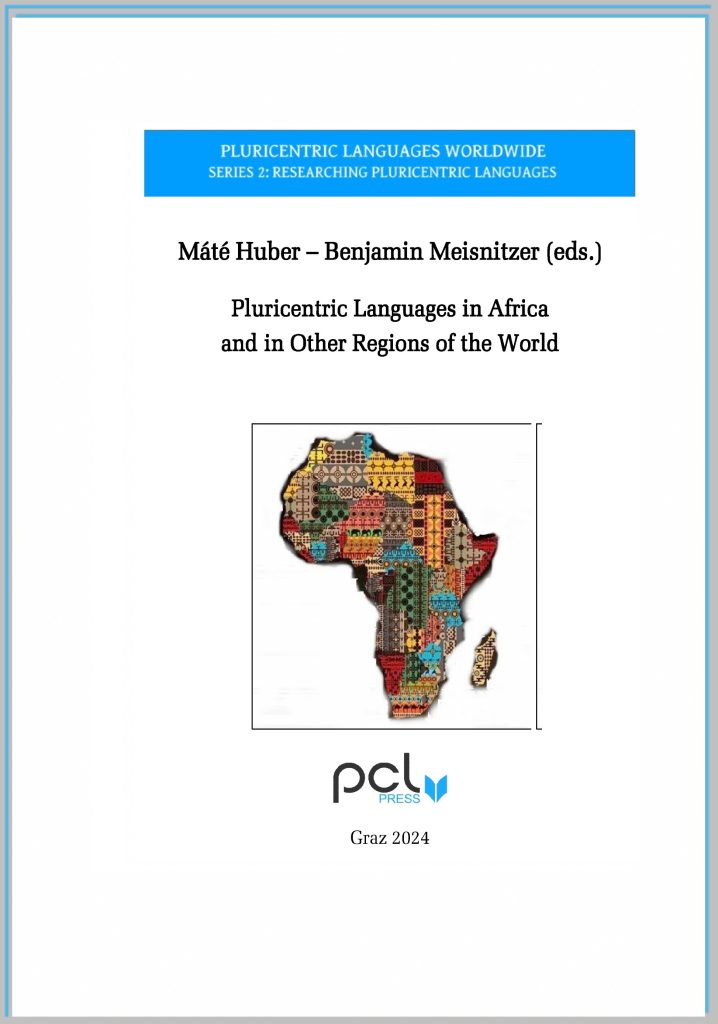Pluricentric Languages in Africa and in Other Regions of the World

This volume contains the proceedings of the 10th International Conference on Pluricentric Languages and their Non-Dominant Varieties. It comprises papers that discuss several pluricentric languages and their non-dominant varieties from different regions of the world, much in keeping with the diverse range of topics that were presented at the online conference that was hosted by the University of Leipzig on August 23-24, 2023. As the subtitle of the conference was Pluricentric Languages, Multilingualism, and Linguistic Dehegemonisation in Africa, the primary focus of the volume is also on pluricentric languages in a highly diverse, multilingual African context. The contributions in the second part of the volume (i.e. the final five papers) are concerned with topics that are related to pluricentric languages and their non-dominant varieties in other areas of the world, such as the Americas, Europe, and the Middle East.
Wie man mit fehlerhaften Korpusdaten Sprachpolitik macht: Der Fall der Variantengrammatik des Deutschen

Dieses Buch präsentiert die Analysen von 200/969 Einträgen der Variantengrammatik (VARGR) des Deutschen anhand eines Vergleichskorpus von 19 Milliarden Wörtern. 60% der Einträge (581) sind demnach falsch bzw. nicht bestätigt. Die Informationen auf der VARGR-Website sind daher äußerst unzuverlässig und oft irreführend. Die VARGR hat eine Reihe sprachpolitischer Ziele. Es sollte bewiesen werden, dass das Standardmodell der Plurizentrik durch die empirischen Daten der Variantengrammatik widerlegt und stattdessen das Modell der Pluriarealität des Deutschen für das Deutsche gültig ist. Dieses Ziel wurde verfehlt und auch das Argument, dass es keine nationalen Varietäten des Deutschen gibt, wurde widerlegt. Die Analysen zeigen ganz eindeutig, dass Deutsch eine plurizentrische Sprache ist.
*******************************************************************************
This book presents the analysis of 200/969 entries of the Variantengrammar (VARGR) of German using a comparative corpus of 19 million words. 60% of the VARGR entries (581) turned out to be incorrect or unconfirmed. The information on the VARGR website is therefore extremely unreliable and often misleading. The VARGR has a number of language policy objectives. The aim was to prove that the standard model of pluricentricity is refuted by the data of the VARGR and instead the model of the pluriareality of German is proved. This goal was not achieved and the argument that there are no national varieties of German was also refuted. The analyses clearly show that German is a pluricentric language.
Pluricentricity in foreign language teaching: The case of English and German in the Hungarian educational system

This book investigates the role of the pluricentricity of English and German in the Hungarian education system. The basis of the study is the research question: What role does the linguistic diversity play in language education in Hungary?
Pluricentric languages in different theoretical and educational contexts

This is the second of two volumes that presents part of the outcome 9th World Conference on Pluricentric Languages that took place from August 26-28 2021. The volume contains eight contributions. Seven of them were presented at the conference. A further paper was included for topicality reasons. The conference was organised by the “Working Group on Non-Dominant Varieties of Pluricentric Lan-guages (WGNDV), this time hosted by the Austrian German Research Centre in Graz. Due to the pandemic and ensuing complications for travelling, the conference was held online via ZOOM much to the satisfaction of all participants.
The conference had three focal points: (1) Pluricentric languages in the Americas; (2) The localisation of global audiovisual and print media in pluricentric language areas; (There will be an extra publication on this theme envisaged by the end of 2022); (3) General section – Pluricentric languages worldwide. The papers of this volume refer to the topics and (3) while the papers of theme (1) are pub-lished in volume (1). A separate volume concerning topic (2) is planned to be published at the end of 2022. The articles of this volume deal with theoretical and educational matters.
Pluricentric Theory beyond Dominance and Non-dominance: A Critical View

The present volume contains ten contributions. Six of them were presented in Stockholm at the workshop “The Theory and Description of Pluricentric Languages- Beyond Concepts of Dominance and Non-Dominance, which was hosted at the conference “The Languages, Nations, Cultures: Pluricentric Languages in Context(s) Conference was held at Stockholm University in May 2019. Four other contributions have been accepted because some of the papers presented at the workshop could not be delivered because of difficulties beyond the control of the authors.
Although many of these papers still utilize the concepts of dominance and non-dominance, they are used to advance the theory of pluricentricity in general or are used as tools to explain other linguistic or social phenomena. Each contribution, in its own way, is a testimony to the usefulness of pluricentricity as a theoretical framework. And, they show that the alternative concept of “pluriareality” that is favoured by some linguists working on German has no theoretical basis and cannot describe pluricentric languages correctly.
Österreichisches Deutsch und andere Varietäten plurizentrischer Sprachen in Europa

Vorträge der 2. Internationalen Arbeitstagung zum Österreichischen Deutsch, vom 25.-26. Oktober 1996 an der Karl-Franzens-Universität Graz.
Österreichisches Deutsch: Linguistische, Sozialpsychologische und Sprachpolitische Aspekte einer Nationalen Variante des Deutschen

Short abstract…
